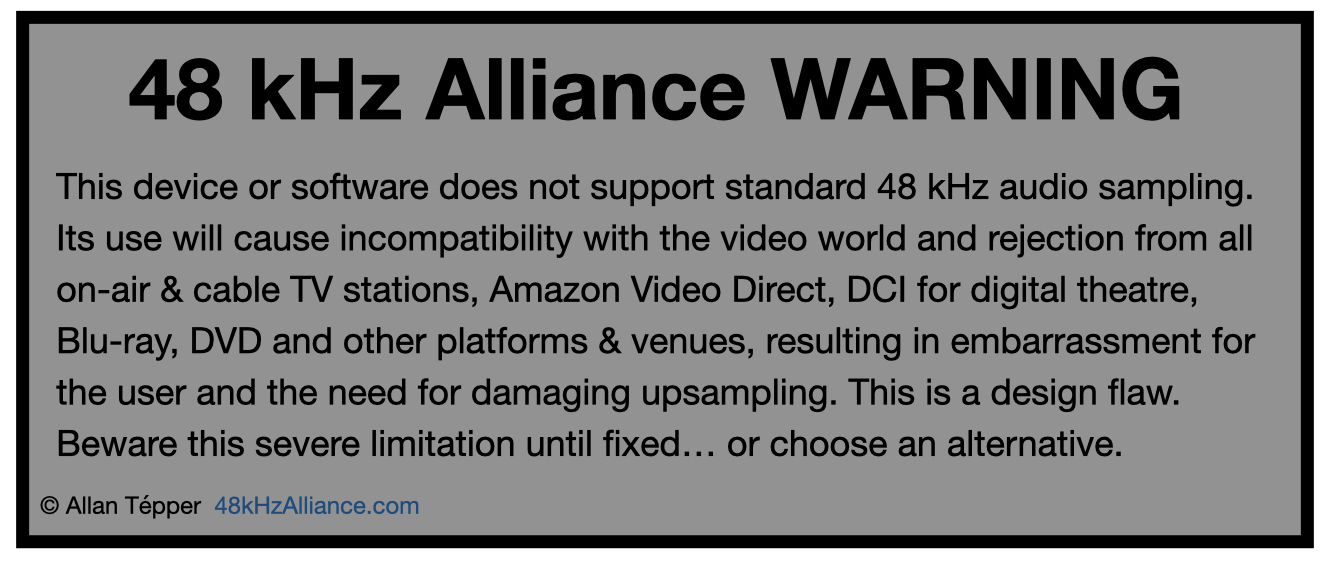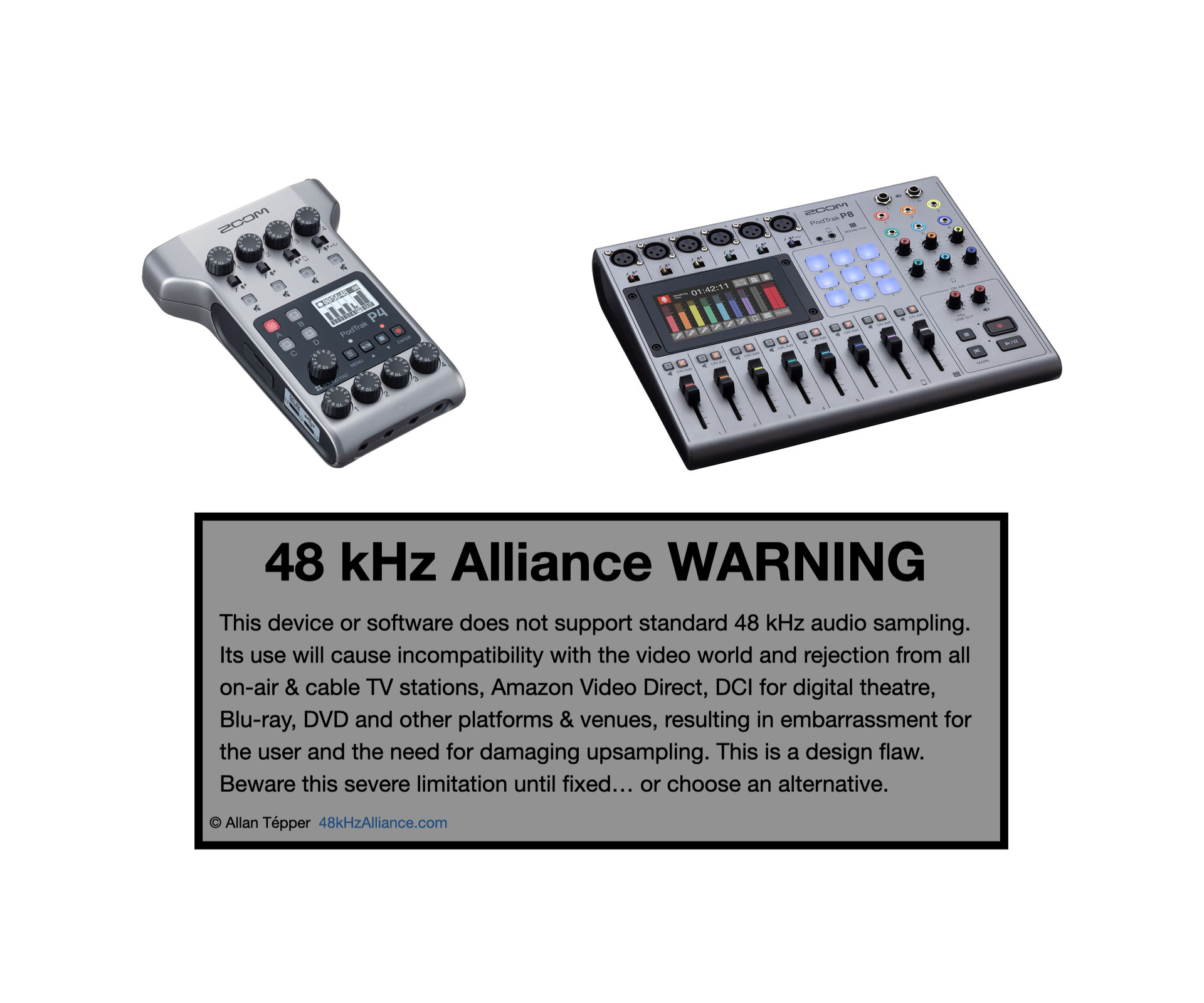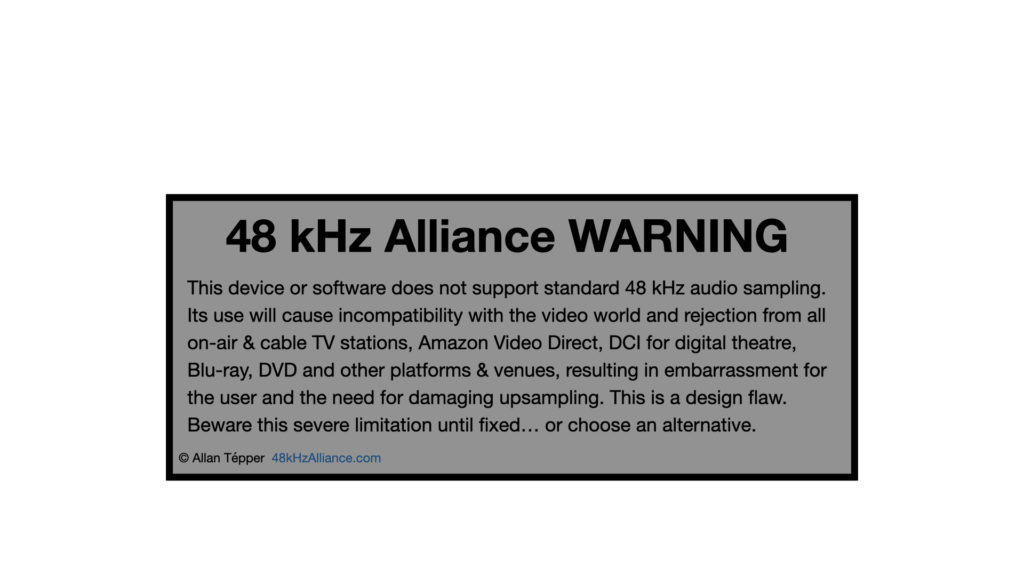Just as in the past, we have seen enslaving practices from video camera and mobile telephone manufacturers, now we see it with software developers and even some hardware manufacturers. I have published plenty about segregated cameras (which artificially limit available framerates by region for strategic marketing reasons) versus worldcams (which freely offer all of their available framerates despite the region). I have also written about locked (enslaved) cellular phones which (often artificially) restrict their use to the original mobile telephone and Internet data provider. In 2019, I created the 48 kHz Alliance, and today I am launching a virtual warning label, similar to the United States’ age-old Surgeon General warning labels about certain harmful recreational consumables. Ahead you’ll see the label and some older —and even newer— examples of software and hardware that artificially limit audio sampling frequencies for different reasons, some out of ignorance and others by intentional strategy.

In this article
- About the text in the label, and why no mention of iBooks Author
- Examples of restrictions I have covered in the past
- Examples of software/devices that were corrected to support 48 kHz (or already had it)
- Motivation for the technical enslavement, in three categories
- Conclusions
Regarding the text in the 48 kHz Alliance Warning label
Here is the text I used in the label:
This device or software does not support standard 48 kHz audio sampling.
Its use will cause incompatibility with the video world and rejection from all
on-air & cable TV stations, Amazon Video Direct, DCI for digital theatre,
Blu-ray, DVD and other platforms & venues, resulting in embarrassment for
the user and the need for damaging upsampling. This is a design flaw. Beware this severe limitation until fixed… or choose an alternative.
Among the venues I mention in the warning label which demand 48 kHz (or optionally, higher sampling frequencies) are:
- All on-air & cable TV stations
- Amazon Video Direct
- DCI for digital theatre
- Blu-ray
- DVD
Some of you may have been wondering why I removed a particular Apple app called iBooks Author (iBA), a tool many of us used to create multimedia ebooks with embedded audio or videos. The reason I decided not include iBooks Author (iBA) in the label are twofold:
- For brevity in the label
- Because iBooks Author (iBA) was discontinued in 2020, with Apple suggesting its own Pages app as a replacement.
However, if you are still using iBooks Author, the 48 kHz requirement still stands in Apple’s own tech article here.
Examples of restrictions I have covered in the past
The following are in alphabetical order of software that should offer 48 kHz but tragically do not yet (or didn’t the last time I checked):
- Adobe Premiere Rush (The professional Adobe apps are immune from this problem.)
- Edward Filowat’s Backpack Studio (Edward has promised in writing to address this limitation in a future update.)
- Apple GarageBand (iMovie and all professional Apple apps like Login Pro and Final Cut Pro are fortunately immune from this limitation.)
- Sennheiser Memory Mic
- Wooji Juice Ferrite
Examples of software/devices that were corrected to support 48 kHz (or already had it)
- All Blackmagic products and software (Did it right from the beginning, with exclusive 48 kHz and/or higher.)
- Apple iMovie (now automatic, as long as first added clip has 48 kHz audio sampling)
- Apple Final Cut Pro (Did it right from the beginning.)
- FiLMiC Pro (Fixed in 2012.)
- LumaFusion (Fixed before 2017.)
- Hindenburg Journalist Pro (Did it right from the beginning.)
- Hooke Audio (Did it right from the beginning, with exclusive 48 kHz.)
- RØDECaster Pro (Did it right from the beginning, with exclusive 48 kHz.)
- RØDE Reporter (Did it right from the beginning, with exclusive 48 kHz.)
- TwistedWave (Did it right from the beginning.)
Motivation for the technical enslavement, in three categories
CAMERAS: segregated vs worldcam
In the case of segregated video cameras, the manufacturers did it to control distribution and to avoid grey marketing. However, due to pressure from purchasers and our editorials here in ProVideo Coalition (most notably this one from 2011, with a powerful statement by Rubén Abruña), first Canon and later Sony both offered paid unlocking services for its HDV cameras. Later, Sony offered a free firmware upgrade to all FS100 cameras which made them worldcam. Most subsequent video cameras over US$2000 were released as worldcam, and several consumer Sony models below US$1000 are also now worldcam. Most of Canon’s and Sony’s mirrorless cameras are worldcam, although many of Canon’s professional video cameras are sadly still segregated. Fortunately, all Blackmagic cameras have always been worldcam.
MOBILE PHONES: locked ve unlocked
Now that the era of contracts for mobile telephony is dead, many providers still entrap naive consumers who are unaware of their options —and advantages— to purchase unlocked phones, by selling them a locked device (often with 24-month interest free financing). Many people in the US are still unaware that they can buy factory unlocked phones (often with —or without— interest-free financing) from Apple, Google, OnePlus, Motorola and other brands. This lack of education is bad for uninformed consumers and good for those carriers that still offer locked phones as a retention mechanism.
VIDEO/ SOFTWARE & DEVICES
Here I’ll give a short list with my speculation in each case.
- Apple GarageBand — Since this audio-only app is otherwise such a similar subset of Apple’s Logic Pro, I suspect it is a decision by Apple to cripple the app, to prevent GarageBand taking sales from Logic Pro for serious audio-for-video production. Ironically, Apple’s own iMovie does support 48 kHz (since it’s a video app, as long as the first edited clip has 48 kHz audio) and iDVD (discontinued since 2011) also. If Apple had made iDVD without 48 kHz support, iDVD would have created DVDs that would have been incompatible with DVD video players.
- Adobe Premiere Rush — I suspect that in this case, it is ignorance among the engineers in Adobe’s consumer division regarding the absolute audio-for-video standard, since in this case, it doesn’t seem to match any other possible reason. This is similar to the first firmware in the Canon 5D MK1 camera, where it exclusively video at exact 30.000 fps, a framerate not used since before 1953 and therefore incompatible with the current television broadcast systems, whose closest one is ≈29.97. In that case, Canon engineers in that factory fell into the trap of taking literally the rounded “30p” in some broadcast video camera menus.
- A tiny amount of targeted Zoom audio recorders and mixers which intentionally lack 48 kHz — See this related article, PodTrak P4 & P8: Will Zoom unlock them, free or for a fee?, illustrated below.

Conclusions
Say “No!” to segregated cameras, locked mobile phones and locked recorders & software which prevent you from recording standard audio. Say “Yes!” to worldcams, unlocked mobile phones and unlocked (or 48 kHz exclusive) recorders and software.
(Re-)Subscribe for upcoming articles, reviews, radio shows, books and seminars/webinars
Stand by for upcoming articles, reviews, books and courses. Sign up to my free mailing list by clicking here. If you previously subscribed to my bulletins and no longer receive them, you must re-subscribe due to new compliance to GDPR. Most of my current books are at books.AllanTepper.com, and my personal website is AllanTepper.com. Also visit radio.AllanTepper.com.
Si deseas suscribirte (o volver a suscribirte) a mi lista en castellano, visita aquí. Si prefieres, puedes suscribirte a ambas listas (castellano e inglés).
Suscribe to my BeyondPodcasting show in English or CapicúaFM en castellano.
FTC disclosure
No manufacturer is specifically paying Allan Tépper or TecnoTur LLC to write this article. Some of the other manufacturers listed above have contracted Tépper and/or TecnoTur LLC to carry out consulting and/or translations/localizations/transcreations. Many of the manufacturers listed above have sent Allan Tépper review units. So far, none of the manufacturers listed above is/are sponsors of the TecnoTur , BeyondPodcasting CapicúaFM or TuSaludSecreta programs, although they are welcome to do so, and some are, may be (or may have been) sponsors of ProVideo Coalition magazine. Some links to third parties listed in this article and/or on this web page may indirectly benefit TecnoTur LLC via affiliate programs. Allan Tépper’s opinions are his own. Allan Tépper is not liable for misuse or misunderstanding of information he shares.
Copyright and use of this article
The articles contained in the TecnoTur channel in ProVideo Coalitionmagazine are copyright Allan Tépper/TecnoTur LLC, except where otherwise attributed. Unauthorized use is prohibited without prior approval, except for short quotes which link back to this page, which are encouraged!

Filmtools
Filmmakers go-to destination for pre-production, production & post production equipment!
Shop Now













